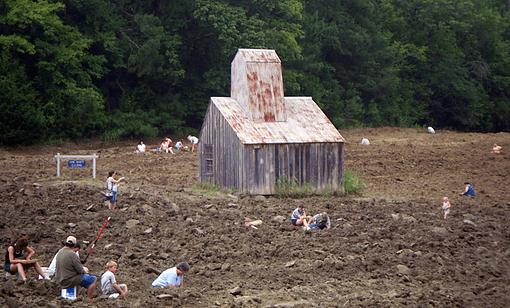
Prospectors at Crater Of Diamonds State Park in Murfreesboro, AR. Photograph by Doug Wertman, distributed under a CC-BY 2.0 license.
In southwestern Arkansas, deep in the humid foothills of the Ouachita Mountains, you’ll find one of the oddest little state parks in the country. On first glance the park seems to be little more than a plowed field edged by scraggly forest, featuring a big public swimming pool and a hulking barn-like structure sheathed in rusty tin siding. You’d likely drive right past it on your way to Murfreesboro or the much more scenic canyon of the Little Missouri River, a few miles down the road.
Yet this seemingly unremarkable patch of ground was designated as one of the world’s most significant natural areas by the International Union for the Conservation of Nature. The feature that attracted the notice of the IUCN naturalists was a geological structure called a Lamprolite Pipe, a kind of subterranean chimney coursing through the upper mantel of the continent down to a seething pool of magma. Lamprolite pipes are rare things. There are only a few known to exist in North America. And these pipelines to the surface of the earth convey even rarer objects formed in the Chthonic depths: diamonds. And not just any diamonds, either: Lamprolite diamonds, prized for their size, clarity and scarcity (98 percent of the world’s diamonds are formed out of Kimberlite). Hence the name of this obscure little park: Crater of Diamonds.
On a summer day in 1906, a corn farmer named John Huddleston was plowing his fields with a pair of mules, when he noticed two gleaming crystal nuggets exposed in a furrow. These two stones proved to be the first diamonds discovered outside of South Africa. Huddleston quickly sold an interest in his farm to what in those days was called a “concern,” a group of Little Rock investment types headed by a cigar-chomping banker named Sam Reyburn.
Over the next few months, trenches were dug, surveys were made, exploratory holes were drilled. Some diamonds were found (about two carats per 100 tons), but not enough to justify the cost of extracting them. By 1908, the Huddlestons’ scarified diamond field was back under the plow, occasionally spitting up a stone or two.
And so it went for about the next 30 years, the outbreak of World War II, things changed. The search for diamonds, critical to the development of new weapons systems, became a priority for the Pentagon. The Department of Defense seized control of the site in 1940 and began intensively mining for the vital crystals. But once again the Ouachita Crater disappointed. Even by the Pentagon’s elastic accounting standards, the labor costs of mining the diamonds proved exorbitant.
In 1951, the Pentagon disposed of the Crater and over the next 20 years several different entrepreneurs attempted to turn the place into a tourist attraction, charging people a few bucks a day to try their hands at shifting for diamonds. All of these ventures ended in failure and in 1972 Arkansas’s progressive governor, Dale Bumpers, acquired the entire 800-acre property for less than $1000 per acre and turned it into Crater of Diamonds State Park, a lazy, off the tracks destination where tourists could leisurely glean the old fields for diamonds.
Then along came Bill Clinton. In 1986, Clinton was introduced to a Canadian mining magnate named Jean-Raymond Boulle. The man who connected Clinton and Boulle was none other than James Blair, the legendary Little Rock fixer and Tyson Foods lawyer, who advised Hillary Clinton during her miraculous adventures in the commodities future market, where she quickly turned a $1000 investment into a $100,000 payday. Boulle had a proposition for the governor. He wanted to restart mining at the old site in the Ouachitas, but needed the governor’s help in winning an exemption from rules forbidding commercial mining in state parks. In exchange, Boulle offered, to incorporate his new company, Diamond Fields, in Arkansas and locate its headquarters in the governor’s hometown of Hope.
The deal was struck, the terms largely negotiated by long-time Clinton consigliere Bruce Lindsay, who would later become the Chair of the Clinton Foundation. This sleazy backroom deal set a pattern that Clinton would mercilessly pursue as president, where the public commons was quietly offered up for exploitation by private enterprises with financial ties to the administration.
Lurking in the background of this secret deal was a Canadian financial tycoon named Frank Guistra, who owned 60,000 shares of stock in Diamond Fields. Over the years, Clinton and Guistra would become close friends, with Clinton travelling the world in Giustra’s private jet, negotiating mining deals from Kazakhstan to Moscow. As detailed in Peter Schweitzer’s very informative Clinton Cash, Giustra returned the love, donating more than $30 million to the Clinton Foundation.
Hillary made out as well. On the night of the first Clinton inaugural ball, the new first lady proudly flashed a 3.5 carat diamond ring, a present from the old Diamond Fields team, mined from the Crater of Diamonds. As for old John Huddleston, the man once hailed as the Diamond King of Arkansas? He died indigent and was buried in a pauper’s grave two miles from his glittering crater.
The moral of this tale: though others may well go under, you can count on the Clintons to always profit from their plunder.
